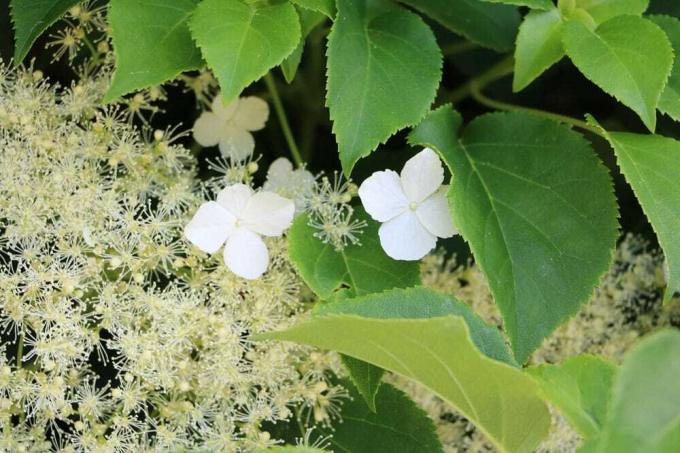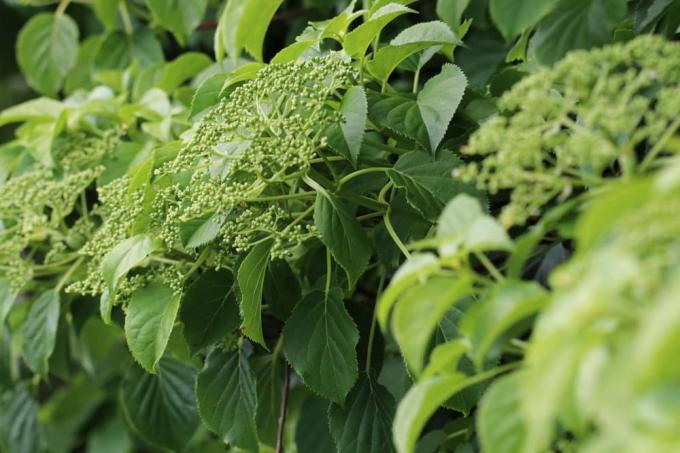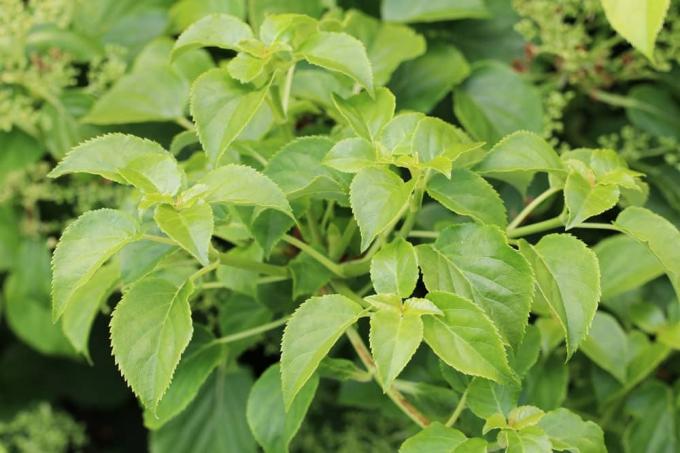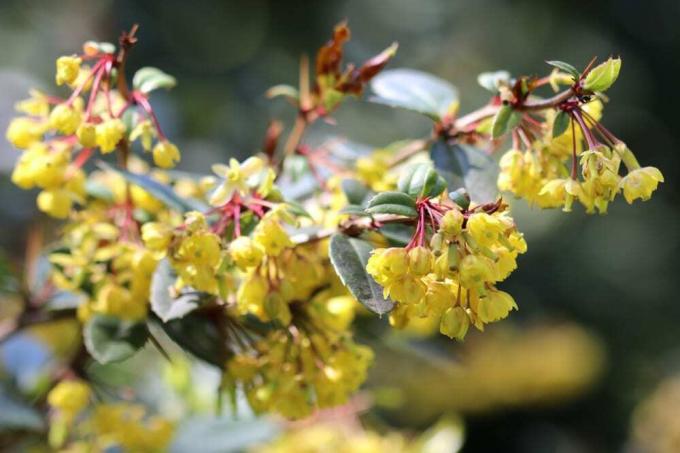

Table of contents
- The right pot
- substrate
- stew
- Location
- Pour
- Fertilize
- Cut
- Useful fall protection
- hibernate
- multiply
- Diseases: leaf chlorosis
- Conclusion
The climbing hydrangea covers drab facades, sober downpipes, bars and fences with a magnificent foliage dress and filigree, white flowers. The skilled climber also accomplishes her decorative work where there is no topsoil available as a subsoil for the planting because the area is paved or asphalted. Clever hobby gardeners pot the hydrangea petiolaris without further ado and place the container at the desired starting point of the floral pull-ups. These instructions explain in detail how to skilfully care for a climbing hydrangea in tubs and pots.
The right pot
Cultivating climbing plants for greening facades, fences and trellises in pots is a viable alternative to classic soil planting. Although this variant is mostly used for the settlement of annual climbing plants, nothing speaks against the care of a perennial climbing hydrangea in the planter. You give a young Hydrangea petiolaris the best starting conditions for vital growth if the pot is designed like this:
- A minimum volume of 10 to 30 liters
- One or more openings in the floor for water drainage
- Stable, non-tilting material such as ceramic, concrete or terracotta
Please do not place the pot in a saucer, as there is a risk of waterlogging after every downpour. It is better if the bucket has feet or you slide some blocks under it. Also choose a light color that reflects the sun's rays if necessary, so that the root ball does not heat up.
Tip:
As a self-climber, the climbing hydrangea tends to develop irrational lines at first. By using a bucket with an integrated climbing aid, you direct the climbing plant in the desired direction of growth right from the start.
substrate
Native to the forests of Korea and Japan, the climbing hydrangea prefers a loose, humus-rich and nutritious soil. Furthermore, a slightly acidic pH value of 5.5 to 6.5 is advantageous, since the plant is designed to be less tolerant of lime. First-class water storage capacity is just as indispensable as reliable permeability, so that no waterlogging develops as a result of compaction. The requirements are not satisfactorily met with standardized growing media, such as standard soil. You can either upgrade commercially available potting soil with additives or mix the substrate for your climbing hydrangea yourself. The following recipes have proven themselves in practice:
- Rhododendron or bog bed soil, enriched with 20 percent expanded clay, fine grit or quartz sand
- A mix of 2 parts leaf compost, white peat and garden soil, 1 part lava granulate and 1 handful of horn shavings
- Alternatively, a mixture of loam, leaf soil, coconut fiber substrate, bark humus, perlite and horn shavings
Since the pH value of self-made substrate mixtures is difficult to assess, please carry out a test at the end. Inexpensive test strips are available at every hardware store and garden center. If the result is below 5.5, raise the value using algae or garden lime. A pH greater than 6.5 is reduced using peat or alum (potassium aluminum sulphate).
stew

While still in the container, place the root ball in a bucket of stale tap water or rainwater while you prepare the tub for planting. If it is terracotta, the pot should have been in water for the previous 24 hours, so that the porous material of a young, freshly planted climbing hydrangea does not lose all moisture withdraws. Lay out a layer of potsherds, grit or expanded clay balls on the bottom of the pot as drainage. Lay a breathable fleece over the water-bearing layer so that the substrate does not later become stuck between the inorganic material. After this preparation, pot the hydrangea as follows:
- Fill the bucket one third with substrate via drainage and fleece
- Unpot the water-soaked root ball and position it in the middle of the ground
- Fill in the substrate all around in portions and press down lightly in between
- Fill in the potting soil up to the bottom pair of leaves
- Leave a pouring edge of 3 to 5 cm
Finally, water the potted climbing hydrangea with lime-free water until a trickle runs out of the bottom opening. If you have chosen a pot with an integrated climbing aid, tie the lower tendrils to the struts without the binding material cutting into the fabric.
Location
Place the pot with the potted hydrangea in a semi-shady to shady spot. On the north wall of the house, in the street with little light or on the shady balcony, the climbing hydrangea fulfills all expectations. A wind-protected location is advantageous so that a strong gust does not tear the tendrils off the facade or climbing aid.
A sunny site facing west or east can also be considered, provided there is enough water available during the warm season. The brighter the location, the more colorful the autumn colors of the leaves are.
Pour
All hydrangeas are characterized by a high water requirement. In this regard, the climbing hydrangea is no exception. At the same time, their low lime tolerance requires a special water quality. This is how you water the climbing leaf and flower ornamental plant professionally:
- Water promptly when the substrate surface has dried
- Preferably use rainwater or decalcified tap water
- Let the irrigation water run slowly onto the root disc
- If possible, do not water the plant overhead
The pouring process is finished when the water flows out through the bottom opening. The sunnier the location, the shorter the intervals between watering. If the climbing hydrangea stands in its dense foliage and blossoms in summer, the high degree of evaporation sometimes requires daily watering. A short finger test provides information about the actual requirement. As long as you can still feel moisture within or at the top 1 to 2 cm, you should not water to prevent waterlogging.
Fertilize

The climbing hydrangea thrives as heart roots with vertical main roots, from which a dense network of fine roots branches out laterally just below the surface of the earth. Solid fertilizers are therefore not recommended, as they have to be raked into the soil, with the risk of damaging the fine roots. Liquid fertilizers, on the other hand, are added to the irrigation water and can be administered without any problems. In order to meet the special nutrient requirements of Asian forest plants, specialist retailers offer liquid fertilizer for hydrangeas. In addition to nitrogen, phosphorus and potassium, these contain other trace nutrients such as iron, manganese and copper in water-soluble form. The administration is very simple:
- Fertilize every 4 weeks from March to September
- Add the hydrangea liquid fertilizer to the irrigation water according to the manufacturer's instructions
- Pour clear water before and after
To support the winter hardiness of a climbing hydrangea, switch to a potassium-rich liquid fertilizer in September. One of the numerous advantages of the main nutrient is that potassium increases the cell sap pressure in the tissue. As a result, the plant is better equipped to deal with the constant change between thaw and frost in winter. At the same time, potassium lowers the freezing point in cell water, which also optimizes frost hardness. Comfrey manure, which is rich in natural potassium, is excellent. Alternatively, liquid potassium fertilizers are commercially available.
Cut
A climbing hydrangea takes between 5 and 8 years to flower. Until then, encourage bushy growth by cutting back the tendrils by a third to the nearest leaf node in late winter. Older specimens already put on the buds for the next flowering period in the previous year, so that the timing and pruning differ from young plants. How to properly proceed with the pruning:
- Cut adult climbing hydrangeas into shape immediately after flowering
- Trim tendrils that are too long to just above a dormant eye
- Trim wilted flowers to discourage sluggish growth of seed heads
A climbing hydrangea is only thinned out in the leafless winter period. If there are no leaves blocking the view of the tendrils in January/February, you can cut and thin out in a more targeted manner. Cut off dead and weak shoots at the base. Otherwise, the branches remain untouched so as not to reduce the summer blossom splendor in advance.
Useful fall protection
In the development phase, the self-climbing hydrangea does not require any climbing aids, as it has stable adhesive roots. In order to guide the climbing hydrangea in the desired direction right from the start on a facade, not only a climbing aid integrated in the pot makes sense. Alternatively, create several fixation points on the ground to help you get started, for example made of beeswax modeling clay. From here, the plant climbs even smooth surfaces in exactly the right direction for greening.
Furthermore, fall protection is recommended, since the adhesive organs are only applied to the young shoots. As a result of the increase in thickness over the years, these adhesive organs tear off. As a result, the majestic climbing hydrangea only holds on to a facade with its young tendrils. This behavior increases the risk that strong winds and storms will detach the plant from the ground in whole mats. By installing a simple cable system in good time, you avoid this risk.
hibernate
Firmly rooted in the ground, a hydrangea is reliably hardy in the right location, so no special precautions need to be taken. This does not apply to a climbing hydrangea in a bucket. Due to the exposed location of the root ball, there is a risk of damage from strong winds and freezing frost. A plant in a pot with a mobile climbing aid should therefore be placed in a frost-free winter quarters. Since the leaves are shed, it can also be dark here. If, on the other hand, a bucket was used as a starting point to green a facade, pergola or arbor, the following measures guarantee a healthy winter:
- Cover the pot with insulating materials before the first frost
- Bubble wrap, jute ribbons or garden fleece are well suited
- Alternatively, surround it with a chain link fence and fill it with leaves, straw or soil
- Water occasionally during the winter to keep the potting soil from drying out
In the first 3 to 5 years, put a breathable hood over the young tendrils so that they do not freeze back in severe frost. Reed mats that you place in front of the climbing hydrangea are also helpful to protect against cold wind and intense winter sun.
multiply
The Hydrangea petiolaris owes its status as a top-class climbing plant not least to a simple propagation strategy. The sinking method works without extensive effort and produces young plants that have the same beneficial qualities of their mother plants. Here's how to do it properly:
- In the spring, fill a 10 liter pot with pricking soil, coconut fiber substrate or peat sand
- Place this nursery pot next to the pot with the mother plant
- Pull a semi-lignified, healthy, non-flowering shoot down to the substrate
- Dig the contact area with the soil 8 to 10 cm deep and weigh it down with a stone

For the shoot end, stick a wooden stick into the ground and tie the tip to it. Pour the sinker moderately with soft water. In the weeks and months to come, the offshoot will remain connected to the mother plant, ensuring its supply of nutrients. Water the soil whenever the surface has dried. A fresh shoot signals that the buried branch has formed its own root system. If you also feel a clear resistance to a slight pull, the sinker can be cut off the mother plant. Repotted in nutrient-rich, acidic substrate, the care program according to these instructions applies from now on.
Diseases: leaf chlorosis
A climbing hydrangea cultivated according to these instructions develops a robust resistance to typical plant diseases. Nevertheless, there can sometimes be reason to complain because the lush green decorative leaves turn yellow. What at first glance looks like a disease is actually the result of iron deficiency. This trace element is sufficiently present in every good potting soil. Nevertheless, deficiency symptoms can occur because iron is no longer absorbed by the roots and transported into the interior of the plant.
If a lime-sensitive climbing hydrangea is watered exclusively with hard tap water, the lime content in the soil accumulates. As a result, iron, magnesium and other microelements become fixed and are no longer available to the plant. This blockage leads to leaf chlorosis. Visible indicators are yellow leaves with green veins. The climbing plant is particularly susceptible in the narrow substrate volume of the tub. How to solve the problem:
- At the first sign, switch the water supply to rainwater or decalcified tap water
- Check the pH in the substrate
- If the result is less than 5.5, repot the climbing hydrangea in an acidic substrate recommended here
In the advanced stage of leaf chlorosis, there is an urgent need for action, as it takes a long time for the roots to absorb iron again. By subjecting the climbing hydrangea to foliar fertilization with liquid iron fertilizer, you compensate for the deficiency where it has an acute effect. As a chelated fertilizer, iron is water soluble and can be applied directly to the foliage using a spray bottle. Please note the special safety regulations, as this fertilizer contains toxic ferrous sulfate.
Conclusion
Planted in tubs, the climbing hydrangea greens facades, fences, downpipes and arbours, even where soil planting is not possible. In semi-shady to shady locations, the climbing artist fulfills the task without requiring a time-consuming care program. A sufficiently large pot with a volume of 10 to 30 liters and a nutrient-rich, slightly acidic substrate guarantee success. An adequate supply of soft water and fertilizer every 4 weeks during the summer mark the central points in care. If the hydrangea petiolaris grows too much for you, you won't mind a summer pruning after the flowering period. The garden year comes to an end by protecting the bucket from frostbite with a winter coat before the first frost.
 garden editorial
garden editorial I write about everything that interests me in my garden.
Learn more about trees & shrubs

Corkscrew willow, Salix matsudana: 13 tips for care
The corkscrew willow is a popular garden tree due to its decorative growth. Especially in winter, the species has a special character that is created by the twisted branches. The maintenance effort for the ornamental tree is limited.

Cutting corkscrew willow: when is the right time?
The corkscrew willow only forms an attractive silhouette if its owner cuts it regularly. The right time for this care measure provides an overview and helps to get the crown in order in no time.

Barberry - care, pruning & propagation
Barberries have been banned from domestic gardens for decades because they serve as a winter host for the black rust fungus. Today, the easy-care and undemanding shrubs can be found more often in the garden. However, planting can be subject to conditions imposed by the Plant Protection Office.

Corkscrew hazel (Corylus avellana): care from A to Z
The care of the corkscrew hazel is not particularly complex. Once the tree has found the perfect location, it can live up to 100 years and reach considerable growth heights. The undemanding species can easily be propagated or regenerated if necessary.

Cut faded flowers when lilacs: why and when?
Lilac is one of the undemanding flowering shrubs that require little care and grow almost anywhere without much intervention by the gardener. When the fragrant inflorescences of the lilac have faded, you should cut them out. Find out here what you should consider when cutting the flowers.

Bush tree care: planting, planting spacing and pruning
The bush tree is a limited-growing tree that is ideal for smaller gardens. These low to medium-growing fruit trees are available in many varieties. In view of the rather small growth habit, a rich harvest can still be expected.
